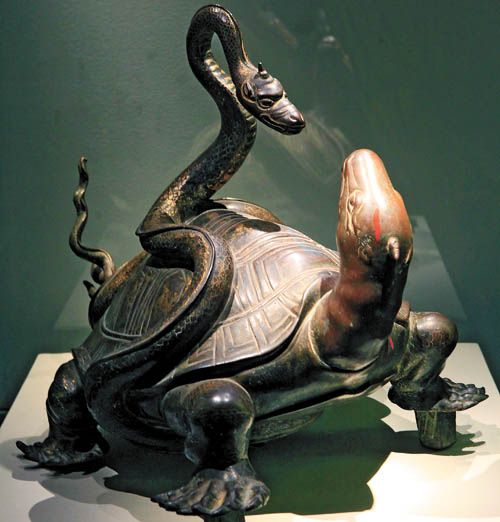
Cao Zhen caozhen0806@126.com PRECIOUS Taoist relics are on display at the Shenzhen Museum showing the rich history of Taoist culture. The exhibits are on loan from Hubei Provincial Museum and Wudang Museum in Central China’s Hubei Province. Taoism is a religious or philosophical tradition of Chinese origin which emphasizes living in harmony with the Tao (literally “way”). The Tao is a fundamental idea in most Chinese philosophical schools; in Taoism, however, it denotes the principle that is both the source, pattern and substance of everything that exists. Taoist ethics vary depending on the particular school, but in general tend to emphasize naturalness, simplicity and spontaneity. The Wudang Mountain, where Wudang Museum is located, has been known as an important center of Taoism for centuries. It is home to a complex of Taoist temples and is renowned for the practice of tai chi. The Shenzhen exhibition displays over 90 works of Taoist art illustrating many facets of Taoist religion dating from the Warring States period (475-221 B.C.). The relics include sculptures of Taoist gods, lacquerware, bronzeware, wood carvings, as well as instruments and ritual items. Among them, a Ming Dynasty (1368-1644) gilded bronze black tortoise statue is a must-see. It is one of the four symbols of the Chinese constellations and is usually depicted as a turtle entwined together with a snake. The creature’s Chinese name “Xuanwu” is identical to that of the important Taoist god Xuanwu, who is sometimes portrayed in the company of a turtle and a snake. In ancient China, the tortoise and the serpent were thought to be spiritual creatures symbolizing longevity. Another prominent exhibit is a set of Ming Dynasty boxwood sculptures of the Eight Immortals, each of which is delicate and vivid. In ancient Chinese mythology, each immortal’s power can be transferred to a power tool that can bestow life or destroy evil. They are revered by the Taoists and are also a popular element in secular Chinese culture. They are said to live on a group of five islands in the Bohai Sea, which include Penglai Mountain-Island. The Eight Immortals are considered to be signs of prosperity and longevity, so they are popular themes in ancient art. Also on display, a grey pottery jar from the New Stone Age used to bury a baby’s remains reveals ancient people’s superstitions. Fine lacquerwares, such as a Qing Dynasty (1644-1911) peach-shaped box carved with Lu Dongbin, one of the Eight Immortals, demonstrate the exquisite craftsmanship. Dates: Until June 21 Open: 10 a.m.-6 p.m., closed Mondays Venue: Shenzhen Museum, Block A, Civic Center, Futian District (福田区市民中心A区深圳博物馆新馆) Metro: Line 2 or 4, Civic Center Station (市民中心站), Exit B | 
